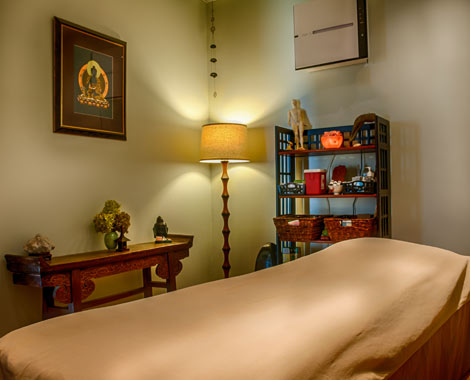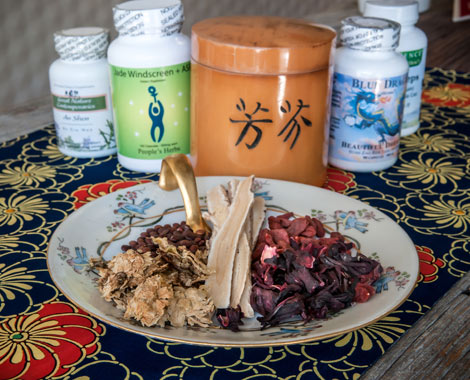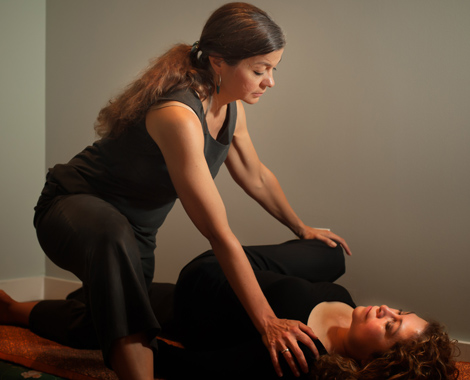Chinese Medicine and Acupuncture
 Chinese Medicine is a holistic system of medicine that can be used to address a variety of ailments from minor injuries to chronic, difficult to treat conditions. It is based on the understanding that the human body is in a dynamic state of balance both internally as well as with the outside environment. If this equilibrium is disturbed then illness can occur.
Chinese Medicine is a holistic system of medicine that can be used to address a variety of ailments from minor injuries to chronic, difficult to treat conditions. It is based on the understanding that the human body is in a dynamic state of balance both internally as well as with the outside environment. If this equilibrium is disturbed then illness can occur.
Treatment with Chinese Medicine features acupuncture and Chinese Herbs, but may also involve bodywork, dietary & lifestyle advice, moxibustion, cupping, gua sha, etc., according to what is appropriate to your specialized Chinese medicine diagnosis.
Chinese medicine diagnosis
Chinese medicine diagnosis is based on the belief that external signs and symptoms reflect the condition of the internal organs. Over thousands of years Chinese physicians have developed a sophisticated system of correspondences between outward signs and internal imbalances, which are reflected in the pulse and tongue. Our highly skilled practitioners use information gleaned from pulse and tongue diagnosis combined with a detailed patient health history and intake to diagnose your condition based on Chinese medicine principals.
Acupuncture
Acupuncture is the safe, gentle insertion of very fine, sterilized acupuncture needles into points along meridians or energy channels in the body. The goal is to increase the flow of qi and blood throughout the body in order to balance the Yin and Yang forces and restore balance and harmony.
Acupuncture activates neurological, muscular, endocrine, and immunological/inflammatory mechanisms. These responses promote healing and physical balance, alleviate pain, provide stress relief, and induce physical and psychological relaxation.
What does Acupuncture treat?
The following is a list of conditions that have been shown to respond to acupuncture treatment by the World Health Organization (WHO). This list is not all inclusive, but offers an understanding of the breadth of conditions that have been treated successfully with acupuncture.
Upper Respiratory Tract
- Acute sinusitis
- Acute rhinitis
- Common Cold and Flu
- Acute tonsillitis
Respiratory System
- Acute bronchitis
- Bronchial asthma (Most effective in children and uncomplicated conditions.)
Eye Disorders
- Acute conjunctivitis
- Central Retinitis Myopia (in children)
- Cataracts (without complications)
Mouth Disorders
- Toothache
- Post Extraction Pain
- Gingivitis
- Acute and Chronic Pharyngitis
Gastrointestinal Disorders
- Spasms of esophagus
- Hiccough
- Gastroptosis
- Acute and Chronic Gastritis
- Gastric Hyperacidity
- Chronic Duodenal Ulcer (pain relief)
- Acute Duodenal Ulcer (without complications)
- Acute and Chronic Colitis
- Acute Bacillary Dysentery
- Constipation
- Diarrhea
- Paralytic Ileus
Neurologic and Musculoskeletal Disorders
- Headache and Migraine
- Trigeminal Neuralgias
- Facial Palsy (early stage, i.e., within 3-6 months)
- Pareses Following a Stroke
- Peripheral Neuropathies
- Sequelae of Poliomyelitis (early stage, i.e., within 6 months)
- Meniere’s Disease
- Neurogenic Bladder Dysfunction
- Nocturnal Enuresis (bedwetting)
- Intercostal Neuralgia
- Cervicobrachial Syndrome
- Frozen Shoulder
- Tennis Elbow
- Sciatica
- Low Back Pain
- Osteoarthritis
- Carpal Tunnel Syndrome
- Back and Knee Pain
- Fibromyalgia
- Chronic Fatigue
- Sports Injuries and Pains
Reproductive & Gynecological Conditions
- Premenstrual Syndrome
- Dysmenorrhea (menstrual cramps)
- Spotting and Excessive Bleeding
- Amenorrhea (Loss of Menstrual Period)
- Impotence
- Infertility
- Incontinence
- Prostatitis
Mental Emotional Problems
- Stress
- Anxiety
- Depression
- Insomnia
Chinese Herbs
 At In Fine Fettle we only use herbs that are prepared according to strict Good Manufacturing Practices (GMP) and subject to high levels of quality control. Chinese herbs differ from western herbs in that they are almost always combined in a formula rather than using herbs singly. Combining herbs is a skilled practice that helps us to craft a formula to address your specific pattern.
At In Fine Fettle we only use herbs that are prepared according to strict Good Manufacturing Practices (GMP) and subject to high levels of quality control. Chinese herbs differ from western herbs in that they are almost always combined in a formula rather than using herbs singly. Combining herbs is a skilled practice that helps us to craft a formula to address your specific pattern.
Our certified herbalists are experts in the full spectrum of botanical medicine—from traditional applications to the most current plant-science research. Our experience and breadth of knowledge enables us to choose the safest, most effective herbal medicines for your needs and conditions. Our commitment to the environment and your safety ensures that we do not use any medicinal substance derived from endangered species nor toxic ingredients.
Cupping
Cupping is a safe and effective adjunctive technique used in acupuncture and Chinese medicine. It has been used in traditional medicine for thousands of years, having roots in Middle Eastern, Asian, Northern & Eastern European and North American traditional cultures.
Cupping therapy is used to treat a variety of ailments and to to improve one’s overall condition. It is effective for the treatment of pain, muscle knots, swelling, and tension, deep scar tissue, and detoxification. It may improve respiratory, circulatory and immune systems.
Gua sha
Gua sha is a massage technique used in acupuncture and Chinese medicine to relieve pain and muscle tension and to speed recovery from a cold. It is applied using massage oil and a smooth, rounded edged instrument like a ceramic spoon. Gua sha improves local circulation and breaks up scar tissue or adhesions in the muscles and connective tissue.
Moxibustion
 Moxa or mugwort (Artemisia argyi, vulgaris) is a dried herb used to warm and stimulate acupuncture points, channels and areas of the body. Moxibustion is the process of safely warming the dried mugwort on or near the body, most often in conjunction with an acupuncture treatment. It improves the circulation of qi and blood and warms and strengthens the body to treat symptoms such as pain, fatigue, some types of infertility, respiratory and digestive disorders. Moxibustion is also used in labor and has been shown to stimulate a breech baby to turn in 69-85% of cases according to various studies.
Moxa or mugwort (Artemisia argyi, vulgaris) is a dried herb used to warm and stimulate acupuncture points, channels and areas of the body. Moxibustion is the process of safely warming the dried mugwort on or near the body, most often in conjunction with an acupuncture treatment. It improves the circulation of qi and blood and warms and strengthens the body to treat symptoms such as pain, fatigue, some types of infertility, respiratory and digestive disorders. Moxibustion is also used in labor and has been shown to stimulate a breech baby to turn in 69-85% of cases according to various studies.
Dietary Recommendations
Practitioners of Chinese Medicine use the healing energetic properties of foods to correct disharmonies within the body. Practitioners have gathered these nutritional principles over thousands of years of practice and have passed them along from generation to generation. These principles make up an integral pillar of Chinese Medicine treatment.
Some general principles in Chinese Medicine nutrition include the following:
- Eat mostly vegetables and healthy whole grains, supplemented with small amounts of everything else.
- Eat mostly cooked and warm food, not too sweet, greasy, oily, or damp.
- Eat in moderation and chew well.
- Drink a teacup of warm water or a warm beverage with meals to facilitate digestion.
- Avoid chilled, cold, or frozen drinks.
Specific recommendations are given based on the individual’s constitution and Chinese medicine diagnosis.
Tui Na
Tui Na means “push pull”. This style of Traditional Chinese medical massage incorporates techniques similar to chiropractic, osteopathic, and physical therapies. Based on principles outlined according to Traditional Chinese Medicine, this modality is used mostly for medical purposes instead of relaxation and works to correct musculoskeletal conditions as well as internal diseases. Tui Na utilizes a variety of hand massage techniques, such as pushing and kneading, rhythmic compression, acupressure, and passive or active stretching in order to relax muscles that are putting unwanted stress on underlying tissues, organs, and bony structures in order to restore correct anatomical relationships.
Shiatsu
Japanese bodywork that involves hand and finger compressions and acupressure along the energetic meridians of the body. Typically performed on floor cushions or mats with the patient dressed in loose clothing, the Shiatsu therapist employs stretching and compression in the treatment. Shiatsu uses very few techniques and can be described as very rhythmic and relaxing. This modality is perfect for stress relief and internal disharmonies.
Deep Tissue/Trigger Point Therapy
Designed to relieve severe tension in the muscle and connective tissue/fascia. This type of massage focuses on the muscles located below the surface of the superficial muscles. Recommended for constant pain, anyone involved in heavy physical activity (such as athletes), and physical injury.
Myofascial Release
 A soft tissue therapy for the treatment of skeletal muscle immobility and pain. Myofascial therapy begins with postural assessments and then works by relaxing contracted muscles, improving blood and lymphatic circulation, and stimulating the stretch reflex in muscles to resolve stress on the skeletal system. This therapy involves deep pressure with active and passive movement of the problematic areas.
A soft tissue therapy for the treatment of skeletal muscle immobility and pain. Myofascial therapy begins with postural assessments and then works by relaxing contracted muscles, improving blood and lymphatic circulation, and stimulating the stretch reflex in muscles to resolve stress on the skeletal system. This therapy involves deep pressure with active and passive movement of the problematic areas.
Thai Bodywork
Nuad Bo Ran, Traditional Northern-style Thai Bodywork, is a slow, rhythmic, meditative style of bodywork that was originally practiced by monks in the Buddhist temples of Thailand. It strives to bring balance to the receiver — body, mind, spirit — using pressing, compressing and stretching techniques. The practitioner maintains mindfulness during the treatment and through touch wishes to impart a sense of compassion and kindness to lead to a deeper healing effect.
Our Wellness Boutique
At In Fine Fettle we have carefully sourced wellness products that are not readily available elsewhere. These include immunity enhancing mushroom products, topical pain relief applications, herbal based skin care products, high quality essential oils, and more.

